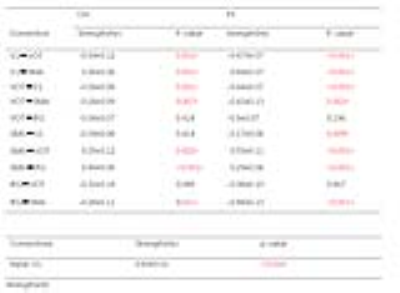2410
Effective connectivity of brain regions involved in word processing: an fMRI study of Chinese character and pinyin in reading1Peking University, Beijing, China
Synopsis
Reading words has been thought to be consist of three underlying constituents including orthographic, phonological, and semantic processing. The relationship between orthographic, phonological, and semantic processing in nonalphabetic language were still unclear. In the present study, we used functional magnetic resonance imaging (fMRI) to scan subjects when they were reading Chinese character and pinyin. Using dynamic causal modeling, we found that Chinese character reading processing was apparently involved ventral stream, and Chinese pinyin reading significantly involved dorsal stream. We conclude that nonalphabetic language with logographic system like Chinese character may needs less assembling phonology when word processing.
Introduction
The differences in language writing systems have different effects on the cognitive processes of word recognition 1,2. The alphabetic system chooses phoneme which is a syllabary system, and the nonalphabetic logographic system, in traditional opinion, chooses morphemes and words to represent spoken language 3. Reading words has been thought to be consist of three underlying constituents including orthographic, phonological, and semantic processing 1. The relationship between orthographic, phonological, and semantic processing in non-alphabetic language was still unclear. Unlike alphabetic writing systems which were mapping graphemes to phonemes, the Chinese logographic system were mapping graphic forms to morphemes, and the written of Chinese was defined at the monosyllabic level 4. In the present study, we used functional magnetic resonance imaging (fMRI) to scan subjects when they were reading Chinese character pinyin. Chinese pinyin is alphabetic symbols that the form-to-sound translation is rely on assembled phonology. We found that Chinese character reading processing was apparently involved ventral stream, and Chinese pinyin reading significantly involved dorsal stream.Methods
Thirty-two right-handed healthy volunteers (16 males and 16 females, ages 18-28 years, mean 22.5) were scanned using a Siemens Prisma 3.0T scanner with a standard head coil. A T2*-weighted gradient-echo EPI sequence was implemented (TR/TE/FA = 2s/30ms/90o. T1-weighted structural images were obtained with 3D-MPRAGE (TR/TE=2.5s/2.98ms, 1mm x1mm x1mm). Each run was about 9 minutes, with two runs included Chinese character and another two runs included Chinese pinyin. The last run included localizer task. A reading ability test was collected after the scan.
Subjects in scanner were reading Chinese character and pinyin, that each kind of character consist of three forms which including a real word, meaningless word, and pseudo-word. And subjects will decide whether the string formed a verb, noun, meaningless word or pseudo-word. There also has a localizer run with the orthographic and phonological task.
fMRI images were performed using SPM12. The first five images acquired during scan were discarded for the T1 saturation effects. Cortical areas that involved in the word processing were defined in 4 regions: V1, ventral occipito-temporal (vOT), supplementary motor area (SMA) and inferior frontal gyrus (IFG). We also checked these activations with the localizer task activation. Beyond that, we conducted a DCM analysis to detect the effective connectivity among these four brain regions. And we formed a model space which contained whole connectivity. Next, to keep a reasonable size in our model space, we placed constraints in the model. Taking into consideration that IFG is the top level in the hierarchy, so we thought IFG received direct input from SMA and vOT, but not from V1. After establishing the model space including all possible models, all subjects’ data were calculated using the expectation maximization (EM) procedure. After the model estimation, all models were entered into Bayes Model Average (BMA) to calculate the average parameters of each connectivity.
Results
During the pinyin task, compared with the effects of pseudo-word, the real word elicited stronger activation in the SMA (0, 8, 58) and IFG (-56, 16, 30). And we also found these areas in the localizer task that phonologic task elicited stronger activation in SMA. While in Chinese character, real word and pseudo-word have similar activations in the SMA and IFG, which goes along with the result 5 that words and pseudo-words activate the same set of regions relative to fixation. Compared with fixation, Chinese real word elicited stronger activations in the V1(-18, -94, 4), vOT(-46, -66, -12), IFG(-56, 16, 30) and SMA (0, 8, 58). (all the activation is under voxel-wise p<0.001, cluster-level FWE p<0.05)
DCM analysis has shown that in the Chinese character model, compared with pinyin, there are strong connectivity between V1 and vOT which mean that nonalphabetic Chinese characters is much involve in dorsal stream. While in Chinese pinyin, the connection between V1 and SMA were strong. That was consistent with the role of the SMA, for which in the dorsal steam was mapping sound to articulation.
Conclusions
These preliminary results showed that nonalphabetic Chinese characters processing rely on the ventral pathway which involved in mapping sound to meaning. While Chinese pinyin, a symbol which needs to spell the phonology and then comprehend the meaning, was involved in the dorsal pathway that played a role in mapping sound to articulation for semantic representations. In this work, we compared Chinese character and pinyin words in reading to explain how information flows in the nonalphabetic language. We conclude that nonalphabetic language with logographic system like Chinese character needs less assembling phonology when word processing.Acknowledgements
No acknowledgement found.References
1. Li Hai Tan, Angela R. Larid, Kari Li et. al. Neuroanatomical Correlates of Phonological Processing of Chinese Characters and Alphabetic Words: A Meta-Analysis. Human Brain Mapping. 2005; 84-91
2. Keith J. Kwabata Duncan, Tae Twomey et al. inter- and intrahemispheric connectivity differences when reading Japanese Kanji and Hiragana. Cerebral Cortex. 2013; 1-8
3. Min Wang, Keiko Koda, Charles A. Perfetti. alphabetic and nonaphabetic L1 effects in English word identification: a comparison of Korean and Chinese English L2 learners. Cognition. 2003; 130-149
4. Wai Ting Siok, Charles A. Perfetti, Zhen Jin, Li Hai Tan. Biological abnormality of impaired reading is constrained by culture. Nature. 2004;71-76
5. Andrea Mechelli. Maria Luisa Gorno-Tempini et al. Neuroimaging studies of word and pseudo-word reading: consistencies, inconsistencies, and limitations. Journal of Cognitive Neuroscience. 2003; 260-271.
Figures


